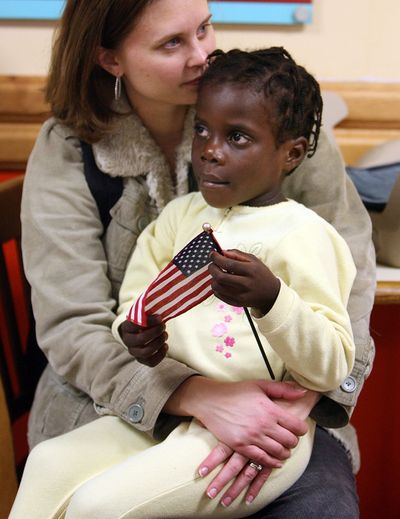Earthquake chaos slows Haiti adoptions

When a deadly earthquake struck Port-au-Prince, Haiti, in January, toppling buildings, leveling shantytowns and leaving thousands without food, shelter or medical care, Chris and Necole Marlow of Austin, Texas, knew what they had to do.
Already considering international adoption, they set their hearts on Haiti.
But four months later, they’re still waiting to get started.
“It’s been kind of frustrating,” Chris Marlow says. “We’re kind of waiting for the Haitian laws to clarify what’s going on.”
The Marlows are among thousands of Americans who have had to put their dream of Haitian adoption on hold while the Caribbean nation struggles to restore basic services and reunite families separated by the disaster.
With Haiti temporarily closed to new adoptions, some have turned elsewhere, to nations such as Ethiopia, China and Russia.
But others, including the Marlows, who run an Austin nonprofit for international orphans, Help End Local Poverty, remain committed to Haiti.
Chris Marlow says he understands that the Haitian government has to make sure potential adoptees really are orphans before new adoptions can begin. For now, he and his wife are focusing on building two orphanages through their nonprofit.
“When summer is over, we’ll see if we can locate a kid (or kids) whose parents have died or whatever, and adopt one or two of them,” he says.
U.S. adoption agencies offer hope, with Thomas DiFilipo, president of the Joint Council on International Children’s Services, saying Haiti may start to process new adoptions again in six months to a year.
“International adoptions (that were already in the works) are just beginning now to move forward again, but it’s an early stage,” he says.
“We’re not encouraging new families to apply for Haitian adoption (yet), but they should stay on top of it, stay engaged.”
After the earthquake, adoption agencies were deluged by calls from Americans wanting to adopt Haitian orphans.
“Some of our organizations have received up to 5,000 inquiries, and not just phone calls,” says DiFilipo. “We’re talking people who are willing to put their names on a waiting list.”
Bonnie Delongchamp, director of communications for Alliance for Children (allforchildren.org), sees a wide-ranging effect: “The earthquake in Haiti really has brought international adoption into the forefront of people’s minds.”
In recent years, China has been the top country Americans choose for international adoption, with 3,001 American adoptions in 2009.
But numbers are down from 2005, when 7,903 Chinese children were adopted. Requirements for adoptive parents are now stricter, and the percentage of kids with special needs is higher.
About 80 percent of the children coming from China now have special needs, some minor. The wait for a child from China is often four to five years, but it can be significantly less if the child has a disability.
Some who decided to adopt from Haiti because of the earthquake have moved on to other countries, says Kim Batts, international services coordinator at Bethany Christian Services adoption agency (bethany.org).
“I think a lot of them, if they hadn’t thought of Haiti previously, they’re generally open to moving in a different direction after they talk to our branch workers and find out about the needs of children throughout the world,” she says.
“The people who are committed to Haiti, we’re finding, are people who have a previous connection to Haiti. They maybe have gone on a mission trip, or their parents used to live there.”
That’s the case with the Marlows, who already have two daughters, ages 7 and 9.
“It’s close to where we live,” Chris Marlow says of Haiti. “We have friends who work there already, so we’ll be able to keep the child involved in his or her country.
“Our organization, we’re going there two to three times a year. So it would just be a real natural fit for us.”